
The landscape of robotics in 2025 is a testament to how technology continuously reshapes industries. With the integration of cutting-edge advancements such as Artificial Intelligence (AI) and Digital Twin technology, robots are enhancing productivity, reducing costs, and driving competitiveness across various sectors. As robotics evolves, it is playing a significant role in transforming industries and creating new opportunities for automation.
In this article, we explore the key robotics trends of 2025 and the innovations that are reshaping industries worldwide.
Artificial Intelligence and Machine Learning in Robotics
AI and machine learning (ML) are at the forefront of transforming robotics, enabling robots to carry out complex tasks with greater autonomy and efficiency. By 2025, robots equipped with AI will be capable of real-time data interpretation, predictive maintenance, and advanced decision-making.
Key Developments in AI and Robotics for 2025:
- Enhanced Autonomy: Robots will be able to handle advanced planning, pattern recognition, and fault prediction independently.
- Real-Time Adaptation: AI will allow robots to adjust their actions based on dynamic environmental changes, improving their effectiveness.
- Improved Connectivity: Specialized AI will improve human-robot interactions, allowing for smoother collaboration and task execution.
With AI, robots will not only perform tasks but also learn and improve continuously, making them more adaptable to various industries.
Collaborative Robots (Cobots): Redefining Human-Robot Interaction
Cobots, or collaborative robots, are designed to work alongside humans, bringing flexibility and efficiency to the workplace. By 2025, these robots will become even more capable, playing a central role in transforming workforce dynamics.
The Evolution of Cobots by 2025:
- Increased Autonomy: Advanced sensors and software will enable cobots to handle more complex tasks and adapt autonomously to their environments.
- Ease of Use: Simplified programming will make cobots accessible to small and medium-sized businesses (SMEs), allowing non-experts to operate them with ease.
- Enhanced Safety: Built-in safety features will ensure that cobots can safely interact with humans, even in high-risk environments.
As cobots become more advanced, their ability to collaborate seamlessly with humans will drive efficiency across multiple industries.
Mobile Manipulators: A Game-Changer in Robotics
Mobile manipulators, which combine mobility with robotic arms, will continue to be a key trend in 2025. These robots are transforming industries by adding mobility to precision tasks, improving efficiency, and reducing operational costs.
Applications of Mobile Manipulators:
- Transport and Handling: Mobile robots will manage dynamic tasks like transporting and handling objects across industrial environments.
- Repetitive Tasks: These robots will excel in performing tasks such as assembly, bolting, and packaging.
- Precision and Mobility: The combination of movement and manipulation makes mobile robots ideal for industries that require both mobility and accuracy.
Mobile manipulators are becoming indispensable in enhancing productivity and streamlining complex operations.
Digital Twin Technology: Virtual Simulations for Optimized Robotics
Digital Twin technology allows the creation of virtual replicas of robotic systems, enabling real-time analysis and optimization without physical risks. This innovation accelerates robot development by testing scenarios and improving performance before deployment.
Benefits of Digital Twin Technology in Robotics:
- Simulated Testing: Virtual models help identify potential failures before they occur.
- Performance Optimization: Robots can be fine-tuned virtually, ensuring peak functionality.
- Maintenance Efficiency: By predicting and preventing mechanical issues, Digital Twins reduce downtime and improve the lifespan of robotic systems.
Digital Twin technology will continue to enhance the development and efficiency of robots across various sectors.
Humanoid Robots: Expanding Service Robotics
Humanoid robots are making significant strides in sectors like healthcare, personal assistance, and exploration. With their enhanced mobility and AI integration, humanoid robots will become more versatile and essential for complex tasks in 2025.
Why Humanoids Matter in 2025:
- Improved Mobility: Enhanced dexterity enables humanoid robots to navigate and interact with their environment effectively.
- Versatile Applications: These robots are being used for a wide range of tasks, from social care to hazardous area inspections.
- AI Integration: Customizable AI allows humanoids to adapt to specific needs and tasks, enhancing their utility across various industries.
As humanoid robots continue to evolve, their role in service robotics will expand, offering more sophisticated solutions to everyday challenges.
Customization and Modularity in Robotics
In 2025, there is a growing demand for customized robots that can meet specific industrial needs. The trend towards modular designs allows robots to be tailored for particular tasks, enhancing flexibility and performance.
Key Trends in Robotics Customization:
- Modular Designs: Robots with interchangeable components, such as the RB-THERON platform, can adapt to various tasks and user requirements.
- Industry-Specific Solutions: Robots are increasingly being designed to address the unique challenges of sectors such as manufacturing, inspection, and maintenance.
- Adaptable Interfaces: With accessible software platforms like ROS, robots can be easily configured and modified for specific applications.
Customization and modularity are driving the next wave of innovation in robotics, enabling industries to implement more efficient, tailored automation solutions.
Sustainable Robotics and Energy Efficiency
As sustainability becomes a top priority, robots in 2025 are being designed with eco-friendly materials and energy-efficient systems. This shift towards green robotics is helping industries reduce their environmental footprint and increase energy savings.
Eco-Friendly Robotics in 2025:
- Recyclable Materials: Robots made from sustainable materials reduce waste and environmental impact.
- Energy Optimization: Innovations in battery technology and power management help robots use energy more efficiently, extending their operational time.
- Green Manufacturing: Robotics manufacturers are adopting sustainable practices, ensuring that production processes align with global environmental goals.
Sustainable robotics aligns with the broader push towards eco-friendly technologies and is poised to play a key role in reducing carbon footprints across industries.
Conclusion: The Future of Robotics in 2025 and Beyond
The robotics landscape in 2025 is marked by groundbreaking advancements in AI, collaboration, customization, and sustainability. These trends are transforming industries by enhancing productivity, improving safety, and fostering innovation. As robotics continue to evolve, their role in driving efficiency and competitiveness will only grow stronger, shaping the future of manufacturing, healthcare, logistics, and more.
With the ongoing developments in robotics, 2025 is set to be a pivotal year for industries embracing automation and AI-powered solutions.












